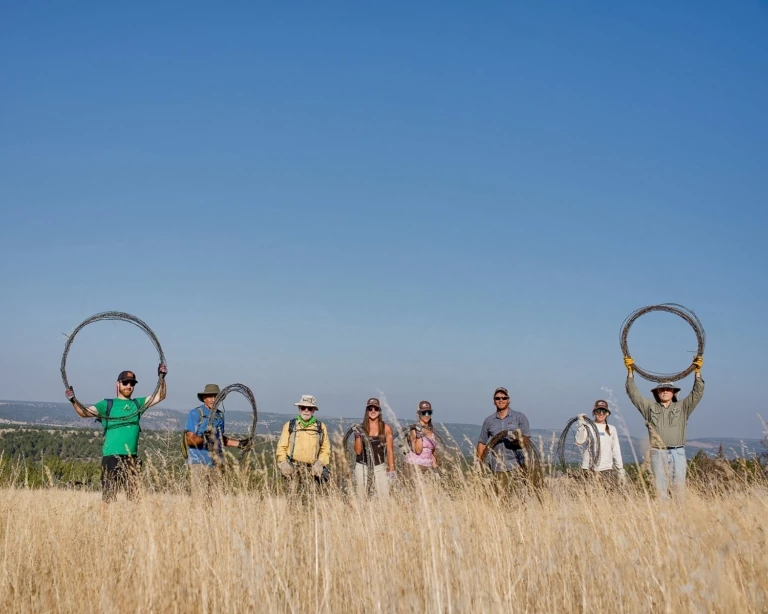Helping Hands in the High Desert
As you leave the lowlands, headed upward and eastward, the land around you changes into something markedly different—with the Cascades as a divider, the thick forests of the coast and the fertile fields of the Willamette Valley give way to the open rangelands, rock outcrops and dry, snaking canyons of the Oregon high desert.
Frigid in winter, sunblasted in summer and wind-scoured at any time of year, the high desert has always been a challenging environment for even the most resilient and well-adapted species. Those challenges have been further intensified by a changing climate and human-caused habitat degradation, but it remains a place where genuine wildness and great ecological diversity can be found—and it’s those qualities that the Oregon Natural Desert Association (ONDA) is working hard to protect.
A grassroots nonprofit based in Bend, ONDA conducts a wide range of ecological restoration projects in the high desert. We’ve supported them through the Patagonia Environmental Grants Program, and we’ve also valued their feedback as field testers for our Workwear line.

The Oregon Natural Desert Association (ONDA) connects volunteers with hands-on conservation and restoration opportunities in Oregon’s high desert. Here, Craig Terry—who has volunteered for Steens Mountain fence pulls for more than a decade—and ONDA’s stewardship coordinator Michael O’Casey discuss the day’s objectives. Photo: Sage Brown
“Oregon’s high desert is home to pronghorn, sage grouse and all sorts of other wildlife that require large swaths of healthy habitat,” notes Ben Gordon, the director of ONDA’s stewardship programs. “Its diversity of life is still intact in many places, but through the years there’s also been a lot of activity that has had damaging effects on the landscape.”
Each year, ONDA’s staff lead over 500 volunteers on multiday projects on both public and private lands throughout the desert’s 26 million acres. The work includes replanting along streams impacted by grazing, removing obsolete barbed wire fencing that impedes wildlife, and monitoring wildlife habitat and wildland conditions to assist government agencies in their management and conservation mandates. ONDA also envisioned, and continues to promote, the Oregon Desert Trail, a 750-mile route through some of the state’s most remote terrain.
“The fence removal work,” Gordon says, “is part of a larger uplands improvement strategy to restore habitat quality and monitor the status of public lands. We pull and remove barbed wire fencing that’s no longer needed and impedes wildlife travel. We also retrofit fences, which involves converting the barbed top and bottom strands so that pronghorn can get under, and mule deer and elk can get over, without becoming ensnared.”

ONDA volunteers have hauled out 63 miles of fencing, weighing 125 tons, from Steens Mountain. Here, a crew celebrates the final pull that left 97,000 acres of wilderness fence free. From left to right: Aaron Hellickson, Andrew Soulek, Craig Terry, Ellysa Lindenmaier, Amber Lamet, Michael O’Casey, Corinne Handelman and Clifford Rone. Photo: Sage Brown
“Down in the valleys,” Gordon continues, “our riparian restoration program aims to make desert streams and river systems as resilient to a changing climate as possible, often through re-establishing native plant communities along the banks. There are riparian areas that were heavily overgrazed for many decades, but now there are willing landowners and agency partners who see the benefit of keeping cows off the stream and river corridors. Once new management plans or appropriate fencing are in place, our volunteers can replant with confidence and help those streams by giving them more shade, keeping them cooler and preserving as much of the desert’s water as we can. On those projects, volunteers plant 500 to 1,000 native plants in a weekend. It’s super hard work, and people bust their backs to get every last plant in the ground.”
From riverbed to ridgeline, many of ONDA’s projects take place in wild areas with no road access—which means hiking miles into the backcountry with heavy-duty hand tools like Pulaskis, McLeods and post removers. “Each person hauls an average of 30 pounds of tools, plus their camping gear,” says Gordon. “It’s tough and slow-going work, but our volunteers are all incredibly dedicated people.”

Camped out after a long day of work in the Steens Mountain Wilderness. Eighteen years ago, this became the first designated wilderness area in Oregon’s high desert. To preserve its wild character, ONDA has helped shape management plans, opposed industrial energy development and removed fences that endanger wildlife. Photo: Sage Brown
In addition to ONDA’s projects on public lands, the organization partners with landowners to help restore privately held land.
“In the John Day River basin,” adds Gordon, “we’ve worked effectively with landowner partners. We’ve even done restoration projects on private land that are supported by government grants. Landowners recognize the great strength in ONDA’s volunteer capacity, and many of them would rather have volunteers working with their hands on the land instead of bringing in machines.
“Those projects stem from a shared interest in wildlife habitat. As we work side by side and share stories around the fire afterwards, landowners who may have been circumspect about these kinds of projects in the past see that ONDA’s volunteers are genuine in wanting to improve the health of the high desert. They’re really out here to help the whole desert, and as a result they’re making the landowner’s personal properties better. It’s a win-win, so we’re looking to work with more landowners throughout the desert.
“Ultimately, we want to do everything we can for native fish and wildlife habitat. And there are strong rural communities out here that we want to see thriving too. So, our emphasis is really on ensuring that the resource—the high desert itself—is as healthy as it can be.”

